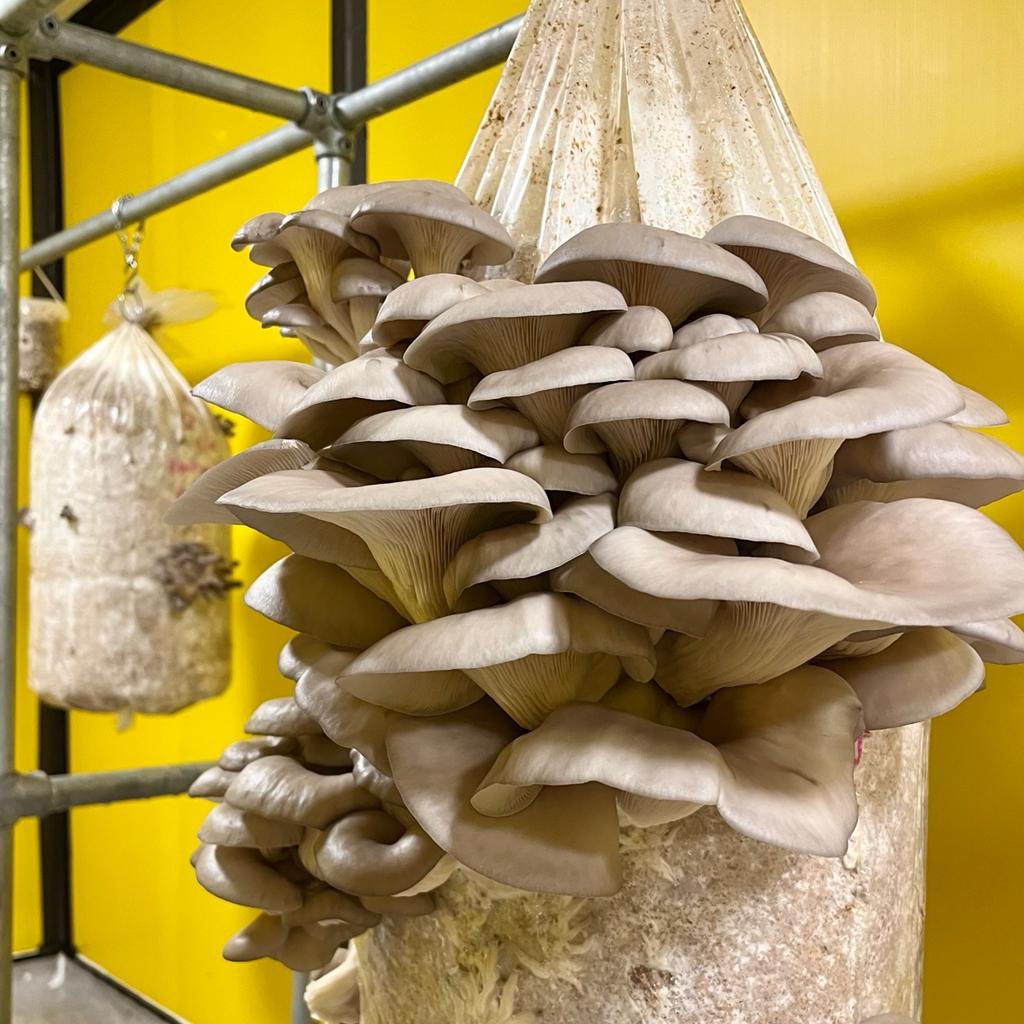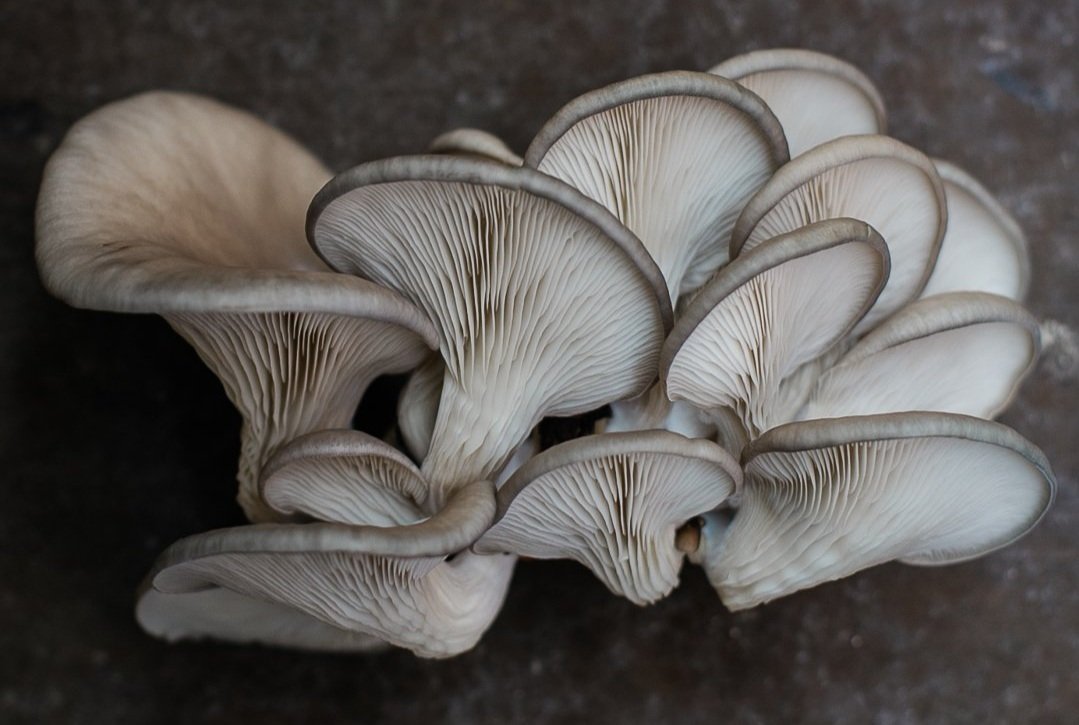Oyster Mushrooms
Spotlight on Oyster Mushrooms:
Geography, Distribution and Ecology:
Oyster Mushrooms are a large genus of mushrooms that includes a wide variety of species, found in ecosystems as diverse as the savannahs of East Africa, rainforests of India and your local park in Scotland.
Oysters are saprophytic mushrooms, meaning they feed on organic matter from dead organisms. More specifically they are primary saprophytes – which means they do the first stage of decomposing organic matter, breaking down recently dead or dying trees by releasing powerful enzymes and acids that can break down and digest the and lignin-cellulose that makes up wood.
Here in Scotland Oysters thrive on a variety of common broadleaf hardwood species such as oak, ash, beech, and alder. They can be found in the wild pretty much year-round but are particularly prolific in spring.
However Oyster mushrooms seem to be able to adapt their enzyme and acid production to break down pretty much any carbon-rich matter. They have been grown on everything from traditional agricultural waste products such as cotton hulls, to urban waste streams like cardboard, paper and coffee. Pearl oyster mycelium can even break down hydrocarbons (aka fossil fuels like oil) and other toxic compounds through a process called mycoremediation.
The worldwide distribution of Oysters is rooted in some common characteristics of this genus; their rapid growth, adaptability to a variety of woody substrates and their aggressive resilience to competitors. The diversity of the genus means we can grow species suited to different climates as our seasons change. In summer we shift production to Pleurotus Djamor, the pink oyster and Pleurotus Citrinopileatus the golden oyster.
These properties make them ideal candidates for indoor cultivation. Indeed Oyster mushrooms were first cultivated in Germany during World War 1 to improve food security in times of shortage and pressure on arable land.
Interestingly Oyster mushrooms in the wild are carnivorous – they hunt and ingest nematode worms to supplement their diet. Nematodes are microscopic worms and one of the most common life-forms on the planet. Since these mushrooms grow up tree trunks they have limited access to nitrogen which is lacking in the woody of mass of hardwood they use as their primary source of nutrients. The Osyter mycelium has therefore volved to trap and digest nitrogen rich sources of protein – nematode worms.
As the Oyster’s hyphae expand three-dimensionally searching for nutrients it exudes aromatic chemicals that attract nematodes towards the mycelium. The hyphae then grow a weapon called a ‘sticky nob’, a lollipop shaped hyphal strand full of toxins that paralyse the nematodes when they come into contact with it. Once paralysed the mycelium sends hyphae down the nematode’s throat and digests it from the inside – gnarly.
Name and Appearance:
The distinctive feature of oyster mushrooms is their kidney shape and their very short stem. Mostly Oyster species also like growing in beautiful big clusters. A notable exception are King Oysters, Pleurotus Eryngii which are actually terrestrial mushrooms - ie. they grow out the ground.
Indeed the name of the genus ‘Pleurotus’ is a latin word which apparently means ‘growing sideways out of’. The ‘Oyster’ or ‘ostreatus’ reflects this mushrooms iconic oyster-like waved caps and silver shimmering colour of the common oyster.
Culinary and medicinal properties:
Pearl Oysters are said to have a rich sweet almond-like taste with notes of anise – would you agree? Oysters really stand out when fried. For best results use a high heat and hot or buttter, allowing the mushrooms to catch and brown, then lower the temperature and add herbs, salt, garlic or other kinds of seasoning. They also do really well in a tempura batter or blanched then cured in lemon juice for a vegan ceviche.
Although not primarily known for their medicinal properties Oysters do have significant health benefits. In particular they have been shown to naturally produce the compound Lovastatin, a substance which is commonly prescribed as a cholesterol regulator. Read more here.
Centuries of industrialisation and decades of intensive consumer culture have left our planet scarred by pollution. We create unimaginable quantities of waste. Oyster mushrooms can turn our waste into food and pollutants into soil - a sort of alchemy for the 21st century that could play an important part in dealing with our complex ecological problems.
As the Oyster’s hyphae expand three-dimensionally searching for nutrients they exude aromatic chemicals that attract nematodes towards the mycelium. The hyphae then grow a weapon called a ‘sticky nob’, a lollipop shaped hyphal strand full of toxins that paralyse the nematodes when they come into contact with it. Once paralysed the mycelium sends hyphae down the nematode’s throat and digests it from the inside – gnarly
Oysters are one of the most commonly cultivated mushrooms around the world due to their ability to adapt and thrive on an incredible variety of substrates including agricultural waste streams like grain husks, straw and peanut shells, as well as urban waste streams such as paper, coffee grounds and cardboard.
This mushroom is also prized by cultivators for its fast growth rate and generous yields – we are currently currently cultivating a winter strain of Pearl Oysters that is adapted to colder climates with an ideal fruiting temperature of 14 C. Oyster mushrooms were first cultivated in Germany during World War 1 to improve food security in times of shortage.



